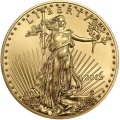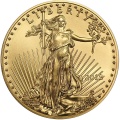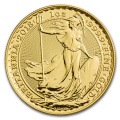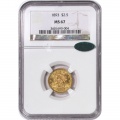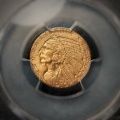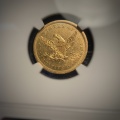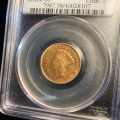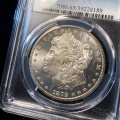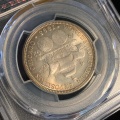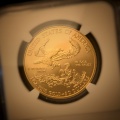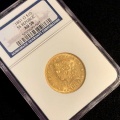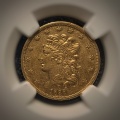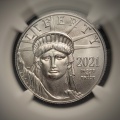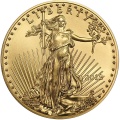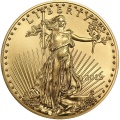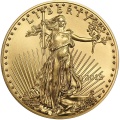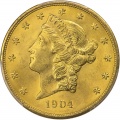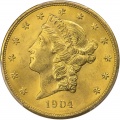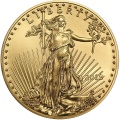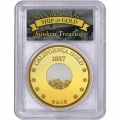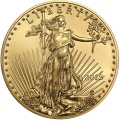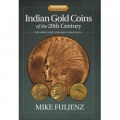August 2022 - Week 2 Edition
Gold Is Making A Run
Gold rose each of the last three weeks and then rose again, from $1,773 to $1,790 on Monday, August 8. So far, it seems the U.S. dollar peaked (and gold bottomed out) on July 14, amid speculation that “peak inflation” occurred in May or June and any recession threat may be over or nearly over. Gold dipped briefly last Friday on an ultra-strong jobs report, as nonfarm payrolls rose by 528,000 jobs in July, more than double the expected 258,000 jobs. Unemployment tied a 52-year low 3.5%, but gold showed great resilience by bouncing back almost immediately, reaching its Thursday high by Monday.
While most investments in paper money, bonds and stock certificates have fallen in 2022, rare coin demand and values have risen. If you have specific needs or a wish list in mind, be sure to communicate those needs to your account representative so you can be first in line when these rarities become available. I am constantly searching for “Wish List” coins for you.
Deficits Threaten Chronic Depression If Not Addressed Soon
With less than two months until the end of Fiscal Year 2022, the Biden Administration is actually on the road to spending slightly less than they did last year, and spending less than $1 trillion in red ink, so what do they do? They pass a massive new spending bill over the weekend! The previous two COVID-fueled deficits were $3.1 trillion in 2020 and $2.6 trillion in 2021, but the strong economy late last year with high tax revenues and fewer spending bills in the first half of this year delivered the chances for a budget deficit under $1 trillion in this 2022 fiscal year, but this good news was apparently “too good to be true.”
Our current debt-to-GDP level is now 130%, since our GDP is $23 trillion and our federal debt has reached $30 trillion (30 divided by 23 is 1.3, or 130%). The cost of servicing this $30 trillion in debt is crippling if we ever return to normal late 20th century historical interest rates of around 5%. That amounts to $1.5 trillion in interest costs per year (5% of $30 trillion), with debts rising each year. Japan has learned that lesson since their debt-to-GDP ratio is 230%, the highest debt burden of any nation in the world.
Japan’s stock market peaked at the end of 1989 and hasn’t come near that level since 1989. Japan was once touted (like China is now) as the “next global Superpower.” It was slated to surpass the United States by the Year 2000 but they are now the #3 economy and may fall further. Japan is also adding another $2 trillion national debt and the Bank of Japan is forced to keep interest rates near zero because Japan cannot service high-interest rate debt. That, in turn, has contributed to the yen falling over 20% in the past year.
For several decades, the yen was one of the strongest currencies in the world, considered a “safe haven” for investors and the key currency in the “carry trade” for arbitrage, but the yen’s latest free fall shows how a once mighty currency can collapse when its central bank’s hands are tied due to too much debt.
If you can’t raise rates, investors won’t buy your paper debt, and your currency collapses. This could happen to the dollar if we creep toward a debt-to-GDP ratio of 200%, like Japan has suffered for decades.
Inflation May Go Down to 5% But Insidious 5% Inflation Can Wipe Out Wealth
Just like creeping debt, creeping inflation can cripple an economy and the dollar. A century ago, the German mark started to disappear, trading 10 per U.S. dollar at the start of 1921, then 10,000 then 10 million, 10 billion and finally 10 trillion per dollar. Can it happen here? Probably not, but the Fed started down a hyper-inflationary path in 2008, as explained by Lev Menand, in a new book, “The Fed Unbound: Central Banking in a Time of Crisis.” The author, an Associate Professor at Columbia Law School, says the Fed started to lose control of the areas it ought to manage, while trying to expand its role in areas it ought not to manage – like bailing out non-bank entities, including Wall Street investment banks and brokers.
In 2008, the new Chairman of the Fed, Ben Bernanke, had been a specialist in studying the Depression years. He had previously honored the great economist Milton Friedman on his 90th birthday (in 2002) by toasting Dr. Friedman, saying, “Regarding the Great Depression. You’re right, we did it. We’re very sorry. But thanks to you, we won’t do it again!” He obviously lived up to that promise, but at great cost.
“In March of 2008, [the Fed] lent $29 billion to prevent the bankruptcy of Bear Stearns… By year-end the Fed had committed $123 billion to save AIG…. The largest loan the Fed had previously made using this authority was $300,000, which it lent to Smith & Corona, the typewriter company, in 1933. Prior to 2008, the total of the Fed’s emergency lending to firms without bank charters in its history was just $1.5 million, all of which it lent during a period, the Great Depression, when nearly a third of the country’s banks closed their doors.”
–From “The Fed Unbound” by Dr. Lev Menard
The Fed was chartered to supervise banks. Who gave the Fed power to decide that Bear Stearns should live, Lehman should die, and AIG should live? That’s the “unbound” nature the Fed took on in 2008. Then, 12 years later, the Fed more than doubled its balance sheet in a few months. Only in the American Revolution, Civil War and World War II did the government come close to that level of inflation.
As we coin collectors know, the U.S. dollar began its slow inflationary death when President Lyndon B. Johnson (LBJ) took silver out of our coins and President Richard Nixon took any gold backing out of our dollar.
First, on June 23, 1965, President Johnson and his brain trust thought we could over-spend on “guns and butter” (Vietnam and more social spending) if we could run up deficits, so he took silver out of our coins to save money – the first devaluation of our silver coins since 1792. But LBJ quickly added this warning.
“If anybody has any idea of hoarding our silver coins, let me say this. Treasury has a lot of silver on hand, and it can be, and it will be used to keep the price of silver in line with its value in our present silver coin. There will be no profit in holding them out of circulation for the value of their silver content.” –LBJ, 1965
Not true, sir! Silver’s fixed price was then $1.29 per ounce. It is now $20.75, up over 1,500 percent.
Then, on August 15, 1971, President Nixon closed the gold window when gold was just $35 per ounce, and gold is now around $1,790 an ounce – up over 5,000 percent in the last 51 years. Looking through the other end of the telescope, today’s paper dollar is worth just two percent of a gold-backed 1970 dollar. Over time, gold has held its value well against all forms of paper money, worldwide.

Important Disclosure Notification: All statements, opinions, pricing, and ideas herein are believed to be reliable, truthful and accurate to the best of the Publisher's knowledge at this time. They are not guaranteed in any way by anybody and are subject to change over time. The Publisher disclaims and is not liable for any claims or losses which may be incurred by third parties while relying on information published herein. Individuals should not look at this publication as giving finance or investment advice or information for their individual suitability. All readers are advised to independently verify all representations made herein or by its representatives for your individual suitability before making your investment or collecting decisions. Arbitration: This company strives to handle customer complaint issues directly with customer in an expeditious manner. In the event an amicable resolution cannot be reached, you agree to accept binding arbitration. Any dispute, controversy, claim or disagreement arising out of or relating to transactions between you and this company shall be resolved by binding arbitration pursuant to the Federal Arbitration Act and conducted in Beaumont, Jefferson County, Texas. It is understood that the parties waive any right to a jury trial. Judgment upon the award rendered by the Arbitrator may be entered in any court having jurisdiction thereof. Reproduction or quotation of this newsletter is prohibited without written permission of the Publisher.


